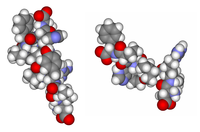
Photo from wikipedia
Recent studies have shown that fascial fibroblasts are sensitive to different stimuli (biochemical or biophysical), promoting extracellular matrix remodeling, as well as synthetic activity. Moreover, the extensive literature on the… Click to show full abstract
Recent studies have shown that fascial fibroblasts are sensitive to different stimuli (biochemical or biophysical), promoting extracellular matrix remodeling, as well as synthetic activity. Moreover, the extensive literature on the renin–angiotensin system (RAS) reported its involvement in tissue remodeling. This study aimed to investigate the presence of RAS components in the deep fascia. Thoracolumbar fascia specimens were collected from 13 patients (age range: 25–75 years; seven males and five females) who had undergone elective spinal surgical procedures at the Orthopedic Clinic of the University of Padova. Gene expression analysis was performed to investigate the expression of Ang II type 1 receptor (AT1R), Ang II type 2 receptor (AT2R), MAS receptor (MasR), angiotensinogen, angiotensin-converting enzyme 2 (ACE2) and angiotensin-converting enzyme 1 (ACE1). AT1R and ACE2 were also measured with immunoblot. AT1R was the most expressed angiotensin receptor subtype (300.2 ± 317 copies/25 ng of mRNA), followed by MasR (37.1 ± 39.56 copies/25 ng of mRNA) and AT2R (147 ± 122 copies/25 ng of mRNA). The amounts of angiotensinogen, ACE1 and ACE2 were hardly detectable. These findings demonstrate that RAS system receptors are present in the deep fascia, with a greater expression of AT1R, suggesting their involvement in fascial remodeling and fibrogenesis.
Journal Title: Biomedicines
Year Published: 2022
Link to full text (if available)
Share on Social Media: Sign Up to like & get
recommendations!